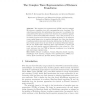Free Online Productivity Tools
i2Speak
i2Symbol
i2OCR
iTex2Img
iWeb2Print
iWeb2Shot
i2Type
iPdf2Split
iPdf2Merge
i2Bopomofo
i2Arabic
i2Style
i2Image
i2PDF
iLatex2Rtf
Sci2ools
EMMCVPR
2011
Springer
2011
Springer
The Complex Wave Representation of Distance Transforms
The complex wave representation (CWR) converts unsigned 2D distance transforms into their corresponding wave functions. The underlying motivation for performing this maneuver is as follows: the normalized power spectrum of the wave function is an excellent approximation (at small values of Planck’s constant—here a free parameter τ) to the density function of the distance transform gradients. Or in colloquial terms, spatial frequencies are gradient histogram bins. Since the distance transform gradients have only orientation information, the Fourier transform values mainly lie on the unit circle in the spatial frequency domain. We use the higher-order stationary phase approximation to prove this result and then provide empirical confirmation at low values of τ. The result indicates that the CWR of distance transforms is an intriguing and novel shape representation. Key words: distance transforms, Voronoi, Hamilton-Jacobi equation, Schrödinger wave function, complex wave represent...
| Added | 20 Dec 2011 |
| Updated | 20 Dec 2011 |
| Type | Journal |
| Year | 2011 |
| Where | EMMCVPR |
| Authors | Karthik S. Gurumoorthy, Anand Rangarajan, Arunava Banerjee |
Comments (0)

